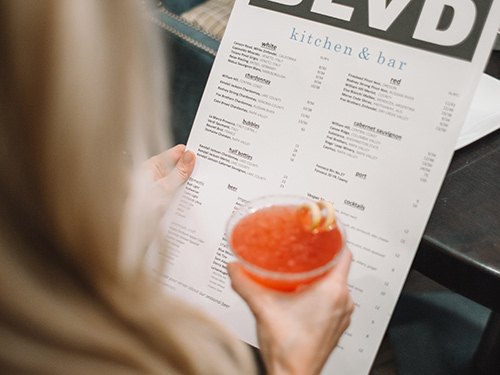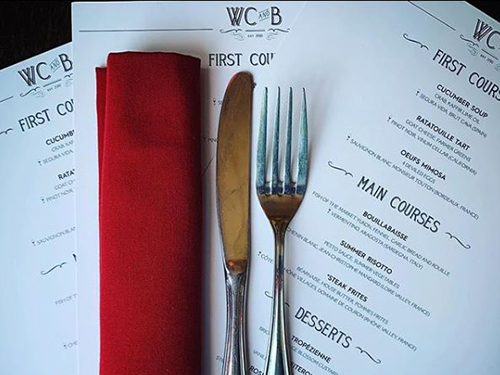The wok wasn’t worthy of this.
A local Korean fusion restaurant had probably the best bulgogi beef I’ve had in a long time. All their food was great, in fact. The servers were friendly and quick.
The place didn’t even last a full year.
As any restaurant owner knows, delicious dishes are only the first step to success. In fact, everything in your restaurant is communicating to your guests: the food (obviously), what your servers are wearing, the art on the walls, the quality of the napkins, the temperature of the room, the music overhead—and your menus.
So, while the bulgogi sang beautifully from its bowl, nothing else sounded very good.
I can’t help with your art or flatware, but have you looked at your menus lately? What are they saying to your customers? (And do you like what they’re hearing?)

Menus are multi-taskers
Your menu wears many hats. It’s a tactile representation of your chef’s talents, but it’s also a communication tool between customer and server—translating a diner’s appetite into a specific fulfillment of that appetite, a way for both parties to speak the same language.
It’s where you communicate certain aspects of your business: where your ingredients come from, your cooking methods, your restaurant’s values, etc. The menu also conveys important practical matters, such as price, business policies, quality and grades of food, and more.
In the end, of course, the menu must quickly and easily convey what you offer to your customers, while standing up to greasy fingers, spilled drinks, and daily wear and tear.
Originally derived from the Latin, “minutus,” or “something made small,” a menu packs a lot into a small package, yet must work hard to accomplish many feats in a short amount of time. Over the years, they’ve provided great insight into our world, as Reynaldo Aljandro writes:
“Menus reflect in sometimes curious ways people’s esthetics and their diets, eating habits, and, perhaps, temperaments. They give us an insight into the social and economic classes of society as well as trends and styles of food service. They present a picture in miniature of the history of food, as well as of the social history of a people.”
At the end of the day, your menu is a marketing and advertising tool for your restaurant. And when used effectively, it can speak positively – as that bowl of bulgogi beef did – about who your restaurant is.
3 ways to make the most of your menus
The problem with menus? Just like burger joints in KC, there are good ones, bad ones and everything in between. Here are a few things to keep in mind as you look at yours, along with a few tips to make some improvements:
Color me hungry – It’s no surprise that color has an effect on emotions. While your menu shouldn’t look like an ad for the circus coming to town, you can nevertheless leverage color in interesting ways. Green, for example, whets the appetite and gives the impression the food is fresh. Yellow brings a happy energy to your menu and can be used as an attention-grabber. If you want to draw attention to certain menu items that offer a higher profitability, use red to inspire action.
A picture is worth … – We can all visualize those garish menus with 28 food pictures that actually make us not hungry. But a high-quality photograph can actually drive orders of a particular item by as much as 30%, which can be a great way to promote certain high-margin dishes. Quality matters, of course, as poor-quality pics can have the opposite effect. And keep it to one or less; any more than that and your menu quickly becomes a Chinese take-out flyer.
Pick your paper carefully – Under that brilliant splash of color and gorgeous photo lies the foundation of your menu. As you’re choosing paper stock, remember it needs to represent your overall brand but also stand up to heavy handling. Small inkjet printers in the back office will not be able to print inks that won’t instantly smear, nor can it adequately make impressions on heavy paper stock. Depending on how often you change up your menus, choose a printer and paper stock that best fits your individual needs. And remember to consider the variety of waterproof and tearproof synthetic stock options, which is the go-to choice for many of our restaurant partners.
Make your menus mean more
The last thing you should do is diminish the role your menu plays in the success of your restaurant or café. The right design on the right paper stock can elevate your guests’ dining experience while also serving as a powerful tool that reinforces your brand. It can serve as a subtle way to encourage cross-selling and upselling, ultimately increasing your profit margins.
If you’re always keeping your ears open to ensure every aspect of your restaurant is singing the same song, you’ll start hearing a beautiful symphony of success.
Dan Woehrman is owner of Callender Printing, offering full-service printing capabilities – including letterpress, offset and digital – with union craftsmen quality. Callender is proud to work with many Kansas City-based restaurants and cafés, providing menu printing and more to drive sales. Share your thoughts on Facebook or on Twitter @CallenderPrint.

CASE STUDY: Read how one local restaurant found better service through printing their menus locally.


Recent Comments